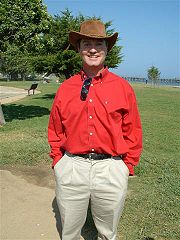
Joseph Polchinski
Encyclopedia

String theory
String theory is an active research framework in particle physics that attempts to reconcile quantum mechanics and general relativity. It is a contender for a theory of everything , a manner of describing the known fundamental forces and matter in a mathematically complete system...
. He graduated from Canyon del Oro High School
Canyon del Oro High School
Canyon del Oro High School, also known as CDO, is a comprehensive public high school in Oro Valley, Arizona, located north of Tucson at the base of Pusch Ridge. Established as a high school in 1964, CDO is one of three high schools of Amphitheater Public Schools and serves about 1,800 students in...
in Tucson, Arizona in 1971, obtained his B.S. degree from Caltech in 1975, and his Ph.D. from the University of California, Berkeley
University of California, Berkeley
The University of California, Berkeley , is a teaching and research university established in 1868 and located in Berkeley, California, USA...
in 1980 under the supervision of Stanley Mandelstam
Stanley Mandelstam
Stanley Mandelstam is a South African-born theoretical physicist. He introduced the relativistically invariant Mandelstam variables into particle physics in 1958 as a convenient coordinate system for formulating his double dispersion relations...
. After postdoctoral positions at SLAC (1980–82) and Harvard (1982–84) he was a professor at the University of Texas at Austin
University of Texas at Austin
The University of Texas at Austin is a state research university located in Austin, Texas, USA, and is the flagship institution of the The University of Texas System. Founded in 1883, its campus is located approximately from the Texas State Capitol in Austin...
from 1984 to 1992. Since 1992 he has been a professor at the University of California, Santa Barbara
University of California, Santa Barbara
The University of California, Santa Barbara, commonly known as UCSB or UC Santa Barbara, is a public research university and one of the 10 general campuses of the University of California system. The main campus is located on a site in Goleta, California, from Santa Barbara and northwest of Los...
and a permanent member of the Kavli Institute for Theoretical Physics
Kavli Institute for Theoretical Physics
The Kavli Institute for Theoretical Physics is a research institute of the University of California, Santa Barbara. KITP is one of the most renowned institutes for theoretical physics in the world. KITP programs bring theorists in physics and related fields together to work together on topics at...
in Santa Barbara.
Polchinski is the author of the two volume textbook, String Theory, published in 1998. Among his contributions to theoretical physics
Theoretical physics
Theoretical physics is a branch of physics which employs mathematical models and abstractions of physics to rationalize, explain and predict natural phenomena...
, D-branes are the best known. In 2008 he won the Dirac Medal for his work in superstring theory
Superstring theory
Superstring theory is an attempt to explain all of the particles and fundamental forces of nature in one theory by modelling them as vibrations of tiny supersymmetric strings...
.
Polchinski's paradox
In 1990, commenting on the Novikov self-consistency principleNovikov self-consistency principle
The Novikov self-consistency principle, also known as the Novikov self-consistency conjecture, is a principle developed by Russian physicist Igor Dmitriyevich Novikov in the mid-1980s to solve the problem of paradoxes in time travel, which is theoretically permitted in certain solutions of general...
(in relation to sending objects or people through a traversable wormhole into the past, and the time paradoxes that could result), Polchinski raised a potentially paradoxical situation involving a billiard ball
Billiard ball
A billiard ball is a small, hard ball used in cue sports, such as carom billiards, pool, and snooker. The number, type, diameter, color, and pattern of the balls differ depending upon the specific game being played...
sent through a wormhole which sends it back in time. In this scenario, the ball is fired into a wormhole
Wormhole
In physics, a wormhole is a hypothetical topological feature of spacetime that would be, fundamentally, a "shortcut" through spacetime. For a simple visual explanation of a wormhole, consider spacetime visualized as a two-dimensional surface. If this surface is folded along a third dimension, it...
at an angle such that, if it continues along that path, it will exit the wormhole in the past at just the right angle to collide with its earlier self, thereby knocking it off course and preventing it from entering the wormhole in the first place. Physicist Kip Thorne
Kip Thorne
Kip Stephen Thorne is an American theoretical physicist, known for his prolific contributions in gravitation physics and astrophysics and for having trained a generation of scientists...
deemed this problem "Polchinski's paradox". Later students of the whimsical problem came up with solutions which managed to avoid any inconsistencies, by having the ball emerge from the future at a different angle than the one used to generate the paradox, and deliver its younger self a glancing blow instead of knocking it completely away from the wormhole, a blow which changes its trajectory in just the right way so that it will travel back in time with the angle required to deliver its younger self this glancing blow.

